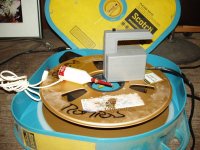Great Hierophant
Veteran Member
In order to completely "erase" magnetic media, it is recommended that you use a degausser. Radio Shack used to sell an inexpensive Audio/Video tape eraser that looks like a black steam iron with a button. As I recall, this is recommended here for degaussing. The end result is a random redistribution of the magnetic particles on the recording medium. Anything previously recorded is deleted and unrecoverable. But I have some questions, and they may be dumb ones, but I want to know some things :
For wound magnetic tape, is the steam iron degausser sufficient? Would the wrapping of the tape shield the inner portions of the tape, i.e. those closer to the spool or reel, from the degaussing effect? Aren't their erasers that run the tape through a machine so there is no question that all areas are properly erased?
For hard drives, can you use the degausser effectively without removing the metal cage covering the platters? Or do you have to touch the platters to the device? Desktop hard drive platters tend to be made of some fairly rigid steel, does the hand-held degausser have the power to randomize the bits?
Floppy disks seem a particularly suitable target for a degausser, as the surface is easily exposed and the covering is very flimsy. Can degaussing make unreliable disks work again? Can you "overdegauss" a disk (or anything else) like overexposing an EPROM to an UV eraser. I know it is not recommended to degauss a CRT too often.
Finally, does degaussing have an effect on nearby electronics? Does it, for example, cause harmful EMP? Will it affect the read/write heads of magnetic disk drives?
For wound magnetic tape, is the steam iron degausser sufficient? Would the wrapping of the tape shield the inner portions of the tape, i.e. those closer to the spool or reel, from the degaussing effect? Aren't their erasers that run the tape through a machine so there is no question that all areas are properly erased?
For hard drives, can you use the degausser effectively without removing the metal cage covering the platters? Or do you have to touch the platters to the device? Desktop hard drive platters tend to be made of some fairly rigid steel, does the hand-held degausser have the power to randomize the bits?
Floppy disks seem a particularly suitable target for a degausser, as the surface is easily exposed and the covering is very flimsy. Can degaussing make unreliable disks work again? Can you "overdegauss" a disk (or anything else) like overexposing an EPROM to an UV eraser. I know it is not recommended to degauss a CRT too often.
Finally, does degaussing have an effect on nearby electronics? Does it, for example, cause harmful EMP? Will it affect the read/write heads of magnetic disk drives?

